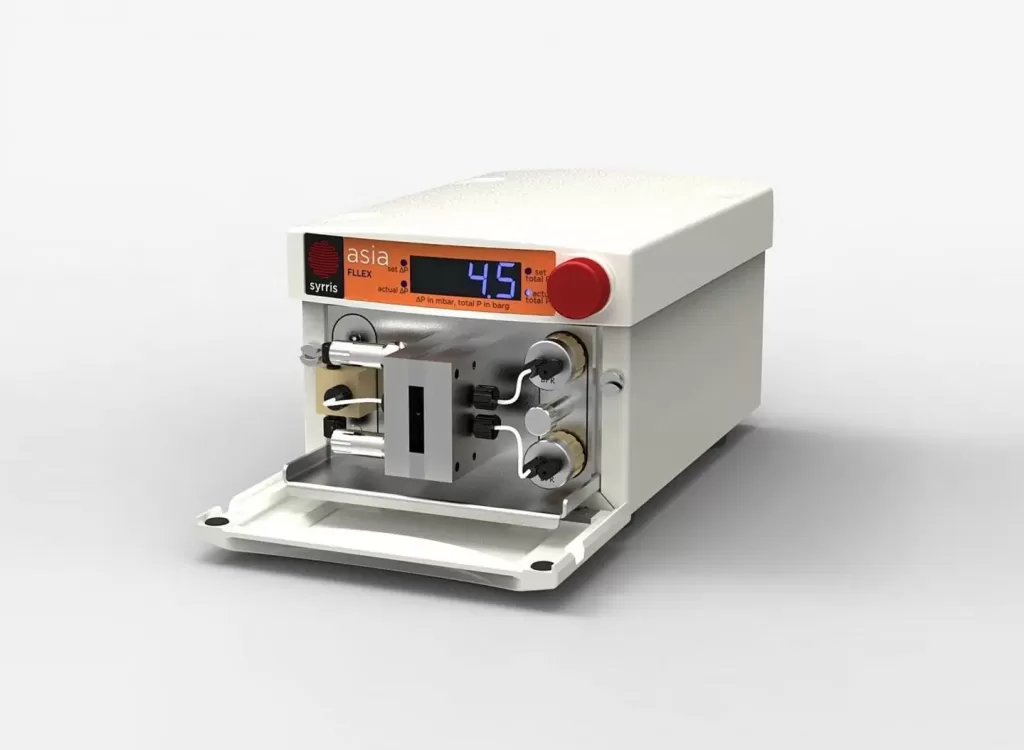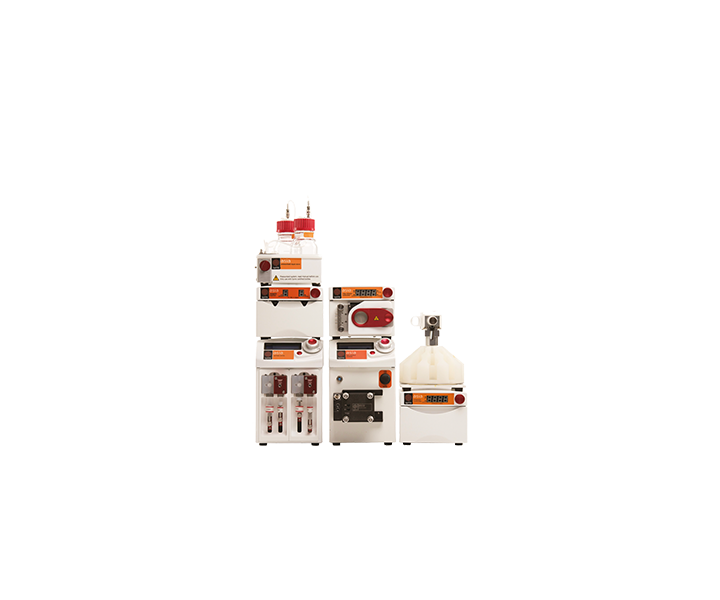Liquid-liquid extraction (LLE)
Liquid-liquid extraction is a purification technique that is used in work-up to separate compounds based on their relative solubilities in two immiscible solvents. It is also called solvent extraction or partitioning.
Inline liquid-liquid extraction
Inline Liquid-liquid Extraction is an extraction technique that works on the same principles as liquid-liquid extraction. The difference is that it happens continuously, as the two liquids (solvents) flow through pipes.
Two liquid solvents, usually water and an organic solvent, are used to separate the solute. The extraction process relies on the higher solubility of the solute in one of the liquids, which acts as the extraction solvent.
Inline liquid liquid extraction explained
In flow chemistry, work-up and subsequent separation of an organic phase (which may include organic compounds such as oils or lipids) and an aqueous phase can be conducted by flowing the input stream across a hydrophobic membrane.
The separation of the two phases is promoted by the cross-membrane pressure which forces the organic phase through the hydrophobic membrane. Both phases can then be fed into separate fluid lines which can go onto collection, waste, or be directed through a separatory funnel for further reactions (multi-step synthesis).
The principles of liquid-liquid extraction in flow are based on the immiscibility of the organic and aqueous phases along with the fluid pressure. Both the overall system pressure and the cross-membrane pressure (CMP) present in the separator section of the apparatus.
In flow, the liquid-liquid extraction apparatus allows the setting of both the system pressure and CMP. The apparatus consists of a separator which contains a hydrophobic PTFE membrane sandwiched between two halves of a separator chip.

The difference between liquid–liquid extraction and solid phase extraction
Liquid–liquid extraction is often used in conjunction with solid phase extraction (SPE) which is another widely used extraction method to purify chemicals more effectively. The difference between the two is that, which liquid–liquid extraction uses two immiscible liquids (or immisible phases), typically an aqueous solution and an organic solvent, as solvents to extract and purify a compound, solid-phase extraction involves a stationary phase (solid sorbent) and a mobile phase (liquid).
Solid-phase extraction can be used to isolate or concentrate the analyte (the compound being extracted) or to remove impurities from the sample matrix. The solid material, or sorbent, is chosen based on its selectivity or affinity to the analytewhich can depend on factors such as polarity, hydrophobicity, or ionization. As the liquid passes through the sorbent, the desired chemical (which can be polar or non-polar, such as ether or acetate) sticks to it, whilst the remaining mixture passes through.
The extracted chemical is then washed out of the sorbent using another liquid, which is called the elution solvent—such as acetonitrile or cyclohexane—which effectively separates the compound of interest.
Solid phase extraction is used with LLE to extract a cleaner, purer product. Since LLE relies on solubility and SPE works on chemical interactions, such as polarity or charge), combining the two can be useful in removing contaminants that a single method might not be able to. In essence, LLE is a bulk extraction method, whilst SPE refines the extract more comprehensively.
What is liquid-liquid microextraction?
Liquid-liquid microextraction, or LLME, is similar to LLE, but it is a separation method for small sample volumes. Instead of bulk quantities, it uses smaller quantities of solvents, which makes it more cost-effective and environmentally friendly during sample preparation.
There are two types of LLME: Dispersive liquid-liquid microextraction (DLLME) and single drop microextraction (SDME).
DLLME uses a dispersive liquid in conjunction with the two immiscible liquids which help break up and distribute the solvent evenly throughout the mixture, increasing mass transfer and enhancing the efficiency of phase separation. The dispersement leads to more contact between the solvent and the sample for a faster and more efficient capture of the desired polar compound or other target substances.
SDME uses a single drop of the extraction solvent, which hangs in the solution, attracting the target analyte. Once a sufficient amount has been collected, that drop can be collected for analysis.
Syrris Asia Liquid-Liquid Extractor
A Syrris Asia Flow Liquid-Liquid Extractor (FLLEX) module enables in-line sample preparation and phase separation for flow experiments.
The combined organic and aqueous phases flow into the separator chip, where the CMP forces the organic phase through the hydrophobic membrane, and if required, to collection. The aqueous phase does not pass through the hydrophobic membrane and can also either be collected or discarded to waste.
A benefit of the ability to integrate the aqueous workup immediately after synthesis is the reduction of impurities, such as acidic compounds, that have occurred due to product degradation.
Once the phases come into contact, they will form alternate slugs in the contacting pipe and this is called “slug flow”. The internal diameter of the contactor section of the pipe is minimal, allowing rapid mass transfer and diffusion of molecules into the preferred slug, speeding up the process of separation. The work-up stage of reactions can occur in-line in seconds as opposed to over several minutes.
Alongside this, liquid-liquid extraction in flow can separate two-phase mixtures that would be extremely difficult by typical techniques e.g. THF and an aqueous phase. As well as reducing the presence of emulsions containing impurities compared to analogous traditional separation techniques.
Once separation is complete both phases are then fed into separate fluid lines which can be fed into collection, waste or go into further reactions downstream depending on the nature of the desired reaction. This is ideal for the preparation of samples before sending directly to analysis, e.g. via a Sampler and Diluter.
